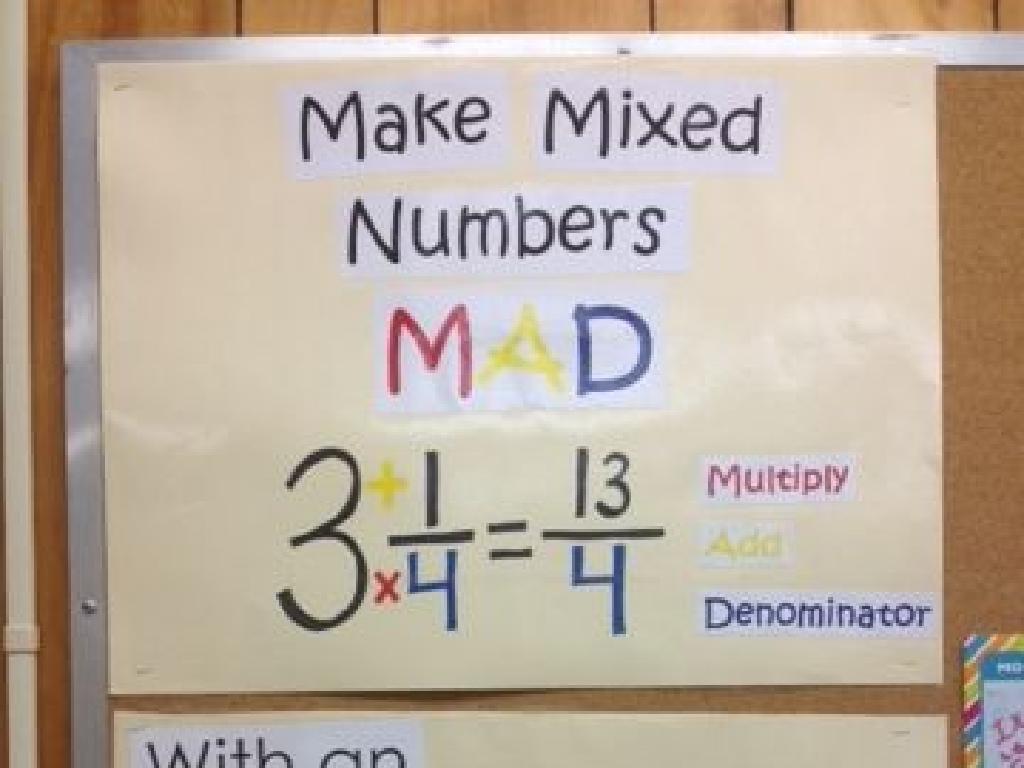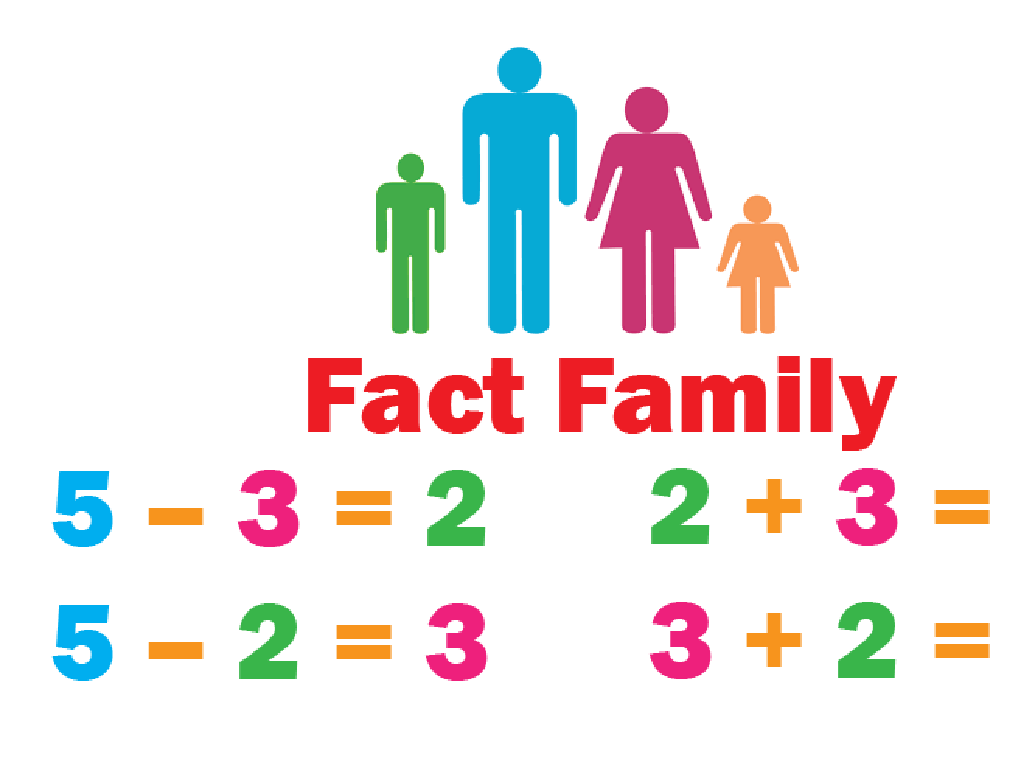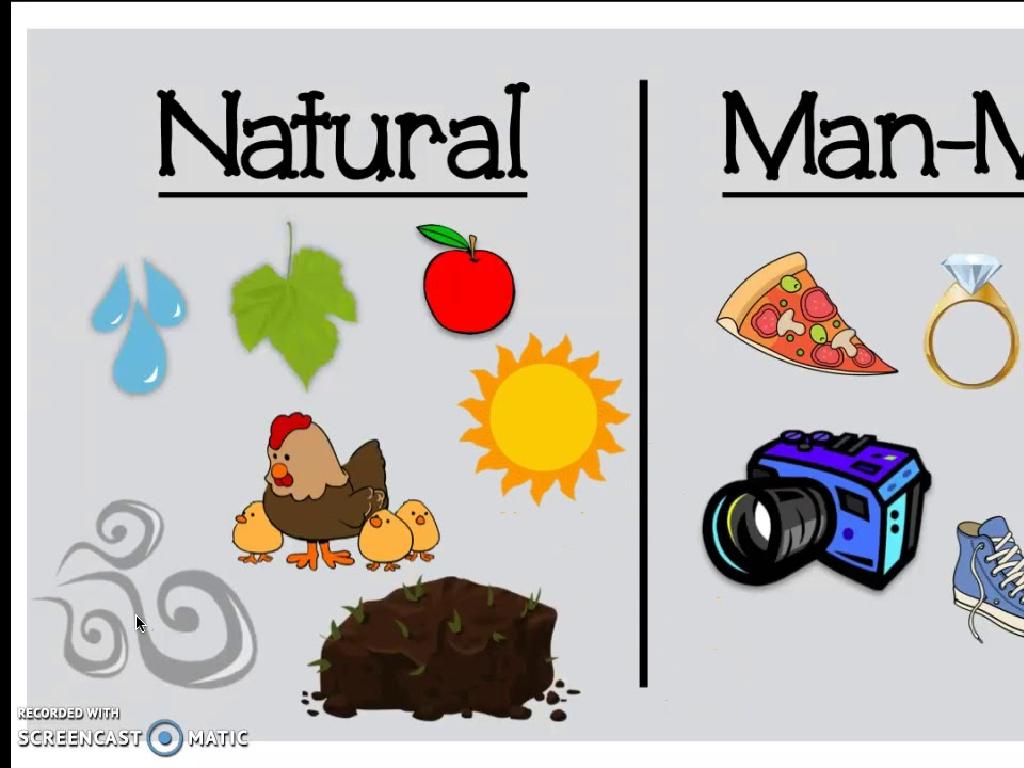Equivalent Ratios: Word Problems
Subject: Math
Grade: Sixth grade
Topic: Ratios And Rates
Please LOG IN to download the presentation. Access is available to registered users only.
View More Content
Understanding Equivalent Ratios
– What are ratios?
– A ratio shows the relative sizes of two or more values.
– Ratios in daily life
– Examples: recipes in cooking, mixing paints, or comparing prices.
– Exploring equivalent ratios
– Ratios with the same relationship. 1:2 is equivalent to 2:4.
– Solving ratio word problems
– Use equivalent ratios to solve problems in stories or real-life scenarios.
|
This slide introduces students to the concept of ratios and their practical applications in everyday life. Begin by explaining that a ratio is a way to compare two quantities, showing how much of one thing there is compared to another. Use tangible examples like recipes or mixing colors to illustrate the concept. Then, move on to equivalent ratios, emphasizing that they are different pairs of numbers that represent the same relationship. Finally, explain that understanding equivalent ratios is crucial for solving word problems that students may encounter in real life, such as determining amounts in recipes or comparing prices. Encourage students to think of their own examples and to practice finding equivalent ratios in various contexts.
Understanding Ratios
– Definition of a ratio
– A comparison of two quantities showing the relative sizes
– Writing ratios in 3 forms
– Ratios can be written as: a to b, a:b, or a/b
– Ratios in everyday life
– Examples: recipe ingredients, speed (miles/hour), or price rates (cost/item)
– Practice with real examples
|
This slide introduces the concept of ratios, which are fundamental in understanding relationships between two quantities. Start by defining a ratio and ensure students grasp the concept of comparison it represents. Show how to express ratios in three different forms, which they will encounter in various mathematical contexts. Provide relatable examples such as cooking recipes, where ratios determine the proportion of ingredients, or speed, which is a ratio of distance over time. Encourage students to identify ratios they come across in their daily lives. Conclude with practice problems where students apply their understanding of ratios to solve word problems, reinforcing the concept.
Exploring Equivalent Ratios
– Understanding equivalent ratios
– Ratios are equivalent if they have the same relationship between numbers.
– Multiplication & division in ratios
– Multiply or divide both terms of a ratio by the same number to find equivalents.
– Real-world ratio examples
– Recipes or map scales use equivalent ratios to adjust quantities or distances.
– Practice with ratio problems
|
This slide introduces students to the concept of equivalent ratios, which are two ratios that express the same relationship between numbers. Emphasize that by multiplying or dividing both terms of a ratio by the same non-zero number, we can find an infinite number of ratios that are equivalent to the original. Provide real-world examples, such as adjusting a recipe for more or fewer people, or using map scales to understand real distances. Encourage students to practice finding equivalent ratios with word problems, reinforcing their understanding through application. This foundational skill will be crucial for their success in more complex math concepts.
Equivalent Ratios in Action
– Solve ratio word problems
– Use given ratios to find missing values
– Identify key problem information
– Look for numbers, units, and the ‘per’ relationship
– Apply equivalent ratios
– If a:b = c:d, then a/b = c/d can solve for unknowns
– Practice with examples
– Try ‘3 red to 4 blue marbles’ in different total amounts
|
This slide aims to teach students how to approach word problems that involve equivalent ratios. Start by explaining the process of solving ratio problems, emphasizing the importance of identifying the key information such as the numbers, units, and the ‘per’ relationship that indicates a ratio. Demonstrate how to apply the concept of equivalent ratios to find missing values in a set of ratios. Provide practice problems for students to apply these concepts, such as finding how many blue marbles would be in a bag if there are 9 red marbles and the ratio of red to blue marbles is 3:4. Encourage students to set up proportions and cross-multiply to find the answer. The goal is for students to become comfortable with translating word problems into mathematical expressions involving ratios.
Solving Word Problems with Equivalent Ratios
– Read the problem as a class
– Highlight the known ratios
– Known ratios are our starting point
– Step-by-step equivalent ratio
– Use multiplication or division to find equivalents
– Solve and check the answer
– Ensure the solution makes sense in context
|
This slide is aimed at guiding students through the process of solving word problems that involve equivalent ratios. Start by reading the problem aloud to ensure understanding. Next, identify the ratios given in the problem. Then, demonstrate how to find an equivalent ratio by multiplying or dividing both terms of the known ratio by the same number. Finally, solve the problem and check that the answer is reasonable within the context of the problem. Encourage students to ask questions at each step and to practice this method with different problems. Provide additional examples if needed and consider pairing students for collaborative problem-solving.
Equivalent Ratios: Practice Problems
– Solve individual ratio problems
– Use the problems provided to practice finding equivalent ratios.
– Discuss solutions with a partner
– Pair up and explain your reasoning to your classmate.
– Group problem-solving session
– As a class, we’ll work through problems interactively.
– Review and reinforce learning
|
This slide is focused on engaging students in active learning through practice, discussion, and group problem-solving. Start with individual practice where students solve problems on equivalent ratios to solidify their understanding. Then, have them pair up to discuss their solutions and reasoning, promoting peer learning. Finally, bring the class together for a collaborative problem-solving session where you can address common mistakes and reinforce the concept. Encourage students to explain their thought process during the group review to enhance their comprehension and confidence in solving ratio problems.
Class Activity: Ratio Scavenger Hunt
– Find objects to form ratios
– Write down your ratios
– Calculate equivalent ratios
– Use multiplication or division to find equivalents
– Share findings with class
|
This interactive class activity is designed to help students understand equivalent ratios through a fun and engaging scavenger hunt. Students will search for objects around the classroom that they can use to create ratios. They might pair pencils to erasers or windows to doors. Once they have their pairs, they should write down the ratios they’ve formed. The next step is for them to calculate equivalent ratios by either multiplying or dividing both terms of the ratio by the same number. After they’ve found an equivalent ratio, they will share their original and equivalent ratios with the class. This will help them see how ratios remain consistent despite being scaled up or down. Prepare to facilitate the activity by guiding students on how to find objects and form ratios, and assist them in calculating equivalents. Have a few examples ready to show them what they’re looking for. Possible activities could include pairing books to shelves, counting colored markers, or matching chairs to tables.
Wrapping Up: Equivalent Ratios
– Review of equivalent ratios
– Significance of ratio mastery
– Understanding ratios is key for advanced math topics.
– Homework: Ratio word problems
– Solve problems to reinforce today’s lesson.
– Practice makes perfect
– Consistent practice is crucial for proficiency.
|
As we conclude today’s lesson, it’s important to recap the concept of equivalent ratios to ensure students have a solid understanding. Emphasize the importance of mastering ratios as they are foundational for future math concepts such as proportions, rates, and even algebra. For homework, students are assigned to solve word problems that involve finding and using equivalent ratios, which will help them apply what they’ve learned in a practical context. Encourage students to practice regularly, as this will help them become more comfortable with ratios and better prepared for more complex mathematical concepts.






